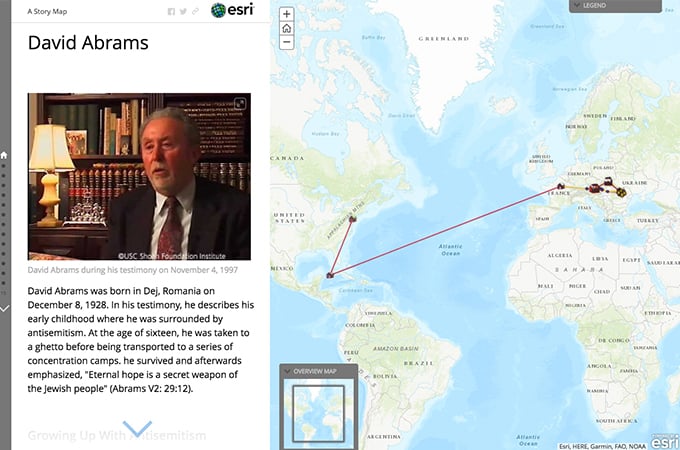Students in the University of Redlands English course called Representing the Holocaust use mapping technology to retell stories of systematic persecution, courage, and resilience shared by those who survived one of history’s most horrific genocides.
“While the focus of the course is on literature—published survivor memoirs—this project broadens the range of stories students study, incorporates organic historical research into the course, and provides a sense of scale of the events [as well as] both temporal and spatial perspectives for each individual story,” says U of R Professor Sharon Oster.
Students begin by listening to survivors’ testimonials, videotaped and archived by the University of Southern California (USC) Shoah Foundation Video History Archive, then further research the information presented.
Using Esri Story Maps, the students go on to map the survivors’ journeys and translate their narratives visually using custom map symbols, defined in a legend, to represent what happened at each location. Combined with survivor quotes, images, and video clips of the testimonials, the Story Maps become interactive multimedia representations of the Holocaust survivors’ experiences.
Recent graduate Ryan Shuman ‘18 knows the stories of the Holocaust all too well. The video testimony he heard and researched was that of his grandmother, Liliane Shuman.
“The story was told to me consistently from about the age of nine,” he says, “with some of the more gruesome details being left out. Mapping helped me conceptualize the chaos of the Holocaust and ‘see’ a story that I had only ever heard verbally.”
The project helped Ryan know his grandmother “even better” and the project provided a “completely different outlook” on her story. “Everyone in our class has sympathy for their survivor in their testimony, but no one [else] had their survivor’s blood running through their body,” Ryan wrote in his reflection paper, noting that at times he broke down and cried. “As much as I tried to keep it academic, this project was personal for me. To rip off a quote from Art Spiegelman, ‘my grandmother bleeds history.’”
Oster notes the exercise of following a series of historical events through one individual’s forced odyssey helps students better appreciate the scale of the Holocaust.
“By mapping the survivors’ journeys, students learn how extensive the Holocaust was, and how innocent people were forced from their homes, dispossessed of all of their belongings, and moved among ghettos, camps, and other internment sites,” Oster says. “Students also see a wider range of the victims singled out for racial extermination: the majority were Jewish (and labeled as such for the purposes of persecution), but the students also studied narratives by individuals criminalized as homosexual and as resistance fighters.”
Student Leah Volchok ‘21 says her greatest takeaway was the opportunity to create her own connection to the past: “As the future generation, we can make story maps to connect us to our ancestors and remember what happened in the past to prevent it from happening in the future.”
Other students came into the class knowing very little of the Holocaust, such as Rebecca Wright ’18, whose knowledge was limited to reading Night by Eli Wiesel. While she knew some of the atrocities, she was surprised to learn “the extent of Hitler’s commitment to the extermination of people he found undesirable,” and of the abundance of camps and their locations.
Many published accounts, Oster says, are written by survivors of the Auschwitz death camp, so many students had only heard of that one concentration camp before starting the project. “The mapping changed [the students’] sense of geography and of the great distances that innocent individuals were forced to travel and move as a consequence of persecution, some never to return to their birthplaces or homes,” she notes. “They came to see the broad scope and scale of the Holocaust by studying one case in fine detail, and then, from there, extrapolating that sense by roughly six million and more.”
This year, students presented their completed interactive multimedia stories to their peers, University faculty, and the community on Holocaust Remembrance Day.






